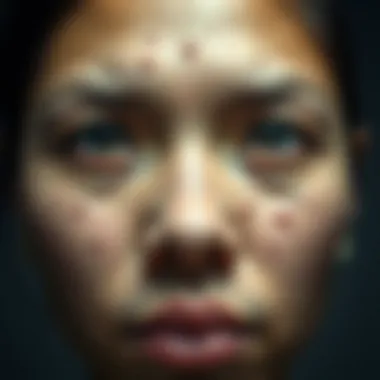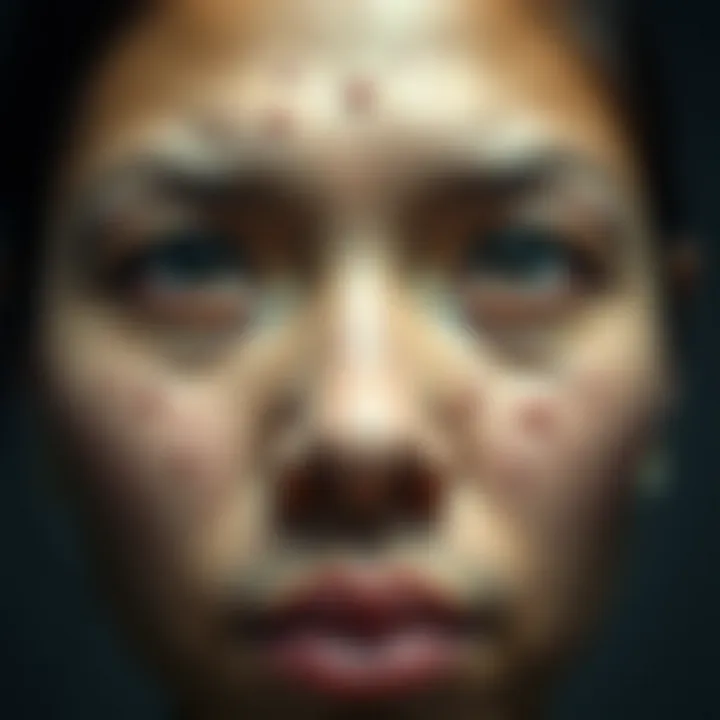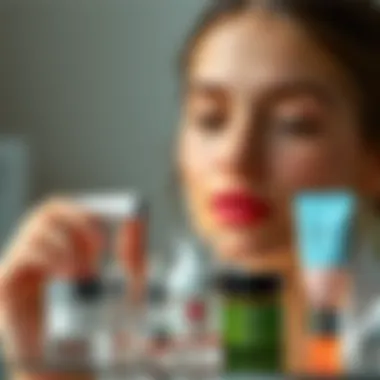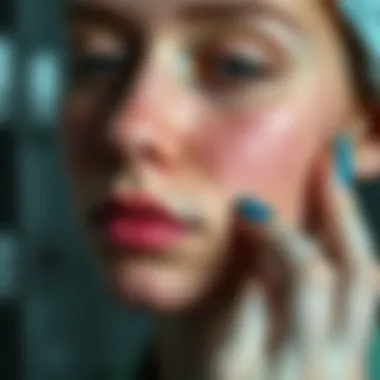Understanding Facial Pimples: Causes and Management


Research Context
Background Information
Understanding the formation and types of facial pimples is crucial for anyone grappling with skin blemishes. Pimples, often considered a nuisance, can stem from various factors including hormonal changes, dietary influences, and environmental conditions. These small formations can signify underlying issues that reach beyond mere cosmetic concerns. Having a grasp of this topic not only aids in improving one’s appearance but can also unveil insights into broader health conditions. Often, individuals overlook how systemic health relates to skin conditions. This article aims to illuminate that connection while offering effective solutions tailored to varying skin types.
Importance of the Study
Facial pimples impact self-esteem and mental well-being. By investigating the various causes and types, we can foster a deeper understanding of managing and preventing these skin issues. This topic is particularly relevant as acne and similar conditions tend to affect a significant population segment, especially adolescents and young adults. Moreover, the modern prevalence of skincare products and treatments requires individuals to be informed consumers. This article serves as a guide, enriching readers with the knowledge needed to make thoughtful decisions regarding their skincare routines.
Discussion
Interpretation of Results
The exploration of facial pimples breaks down their formation into major categories, such as hormonal, environmental, and nutritional factors. For instance, hormonal changes during puberty often lead to a surge in oil production in the skin, resulting in clogged pores and subsequent pimple formation. Environmental stressors such as pollution can further exacerbate skin conditions by introducing external irritants. Recognizing these triggers is the first step toward effective management.
Comparison with Previous Research
Research has long indicated that a multifactorial approach is needed to tackle skin concerns. Past studies, for instance, have identified a clear link between diet, particularly high glycemic index foods, and acne breakouts. While earlier research may have focused predominantly on topical treatments, newer findings take a more holistic view, emphasizing lifestyle adjustments and individual skincare regimens. Hence, it’s valuable to consider both historical findings and contemporary analyses when discussing facial pimples to encourage a well-rounded approach in treatment protocols and preventative measures.
"Skin health often reflects overall health, thus addressing pimples may involve more than just topical solutions."
By synthesizing this knowledge, readers can better navigate their skincare challenges and adopt strategies that align with their specific needs.
Foreword to Facial Pimples
Facial pimples, while often dismissed as a mere nuisance, represent a complex interplay of physiological and environmental factors. A solid grasp of this subject is crucial, especially for those affected directly or indirectly. Understanding the underlying mechanisms behind pimple formation can facilitate targeted approaches for prevention and management.
By delving into the specific causes and classifications of facial pimples, individuals can distinguish between various types of acne and tailor their skincare regimens accordingly. This knowledge can lead to effective strategies that not only address current breakouts but also help avert future occurrences. Moreover, recognizing the significance of external influences—such as diet, stress, and pollution—allows for a holistic approach to skin health.
Instead of relying solely on over-the-counter treatments or home remedies, armed with knowledge, one can make informed decisions about effective interventions, boosting both appearance and confidence. This section thus sets the stage for a comprehensive examination of facial pimples, providing a foundation for understanding their impact on skin health.
Defining Facial Pimples
Facial pimples are a manifestation of acne vulgaris, a skin condition characterized by the blockage of hair follicles due to excess oil production, dead skin cells, and bacteria. Primarily, they appear on the face, neck, chest, and back, where sebaceous glands are most abundant. The term 'pimple' generally encompasses various types, including whiteheads, blackheads, and more inflamed lesions like papules and pustules.
The specific presentation of these pimples can vary, with closed comedones appearing as small flesh-colored bumps and open comedones taking on a darker appearance due to trapped oil and dirt. Understanding these definitions lays a framework for recognizing and categorizing acne types, which is essential for effective treatment decisions. Furthermore, the visibility and persistence of facial pimples often impacts individuals' self-esteem and social interactions.
Historical Perspectives on Acne
Acne’s journey through history reflects changing societal perceptions and medical understanding. In antiquity, skin conditions were often attributed to imbalances in bodily humors. Ancient Egyptians utilized natural oils and herbs in hopes of alleviating symptoms, while the Greeks advocated for diets rich in vegetables and grains.
Fast forward to the 19th century, when the medical community began to link acne with hormone fluctuations, particularly during puberty. Thomas Sydenham, a prominent physician of the time, noted that acne often plagued adolescents, referring to it as a sign of youthful vitality.
In modern times, with the advent of more rigorous scientific study, the understanding of acne has pivoted significantly. Researchers now recognize that a combination of genetic, hormonal, and environmental factors intertwine to influence acne severity and type. Notably, the discovery of the role of androgens in sebum production created a scientific framework for developing treatments targeting hormonal imbalances. As such, recognizing these historical contexts not only enriches our understanding but encourages a more empathetic approach to those battling acne today. The topic of facial pimples has evolved from myth to science, underscoring the importance of ongoing research and education.
Anatomy of the Skin
Understanding the anatomy of the skin is crucial when discussing facial pimples, as it provides insight into how and why they form. The skin, often taken for granted, acts as a protective barrier while also hosting numerous biological processes. Knowing the structure and functions of the skin helps in recognizing how various factors can influence pimple formation. Each layer of skin has distinct roles that contribute to its overall health and, ultimately, skin appearance.
Skin Structure and Function
Layers of the Skin
The skin is composed of three main layers: the epidermis, dermis, and subcutaneous layer. The epidermis is the outermost layer, acting as the first line of defense against environmental aggressors such as bacteria and UV radiation. It also contains melanocytes, which are responsible for skin pigmentation. The dermis, located beneath the epidermis, houses blood vessels, nerves, and connective tissue. Its structural integrity is paramount for providing elasticity and support. The deepest layer, the subcutaneous layer, primarily consists of fat cells that offer cushioning and insulation.
Notably, the epidermis is made up of several sub-layers, each with specific functions that cycle rapidly, shedding dead skin cells usually every 28 days. This continual renewal is vital since it prevents the clogging of hair follicles, a common precursor to acne. Therefore, knowing about these layers is beneficial as it underlines the importance of maintaining skin health through proper exfoliation and moisturization practices.
Sebaceous Glands
Embedded within the dermis, sebaceous glands play a pivotal role in skin health by secreting sebum, an oily substance that keeps the skin lubricated. These glands are directly connected to hair follicles. When functioning well, sebum helps maintain moisture and provides a minimal barrier against environmental damage.
However, problems arise when these glands produce excess sebum, leading to oily skin, which can contribute to clogged pores and, inevitably, pimples. Understanding the size and activity of these glands can help individuals tailor their skincare regimens by utilizing products that either balance oil production or target acne more effectively.
Hair Follicles
Hair follicles are the tiny openings in the skin where hair grows. They also serve as conduits for the sebaceous glands, making them vital in understanding acne development. The lining of hair follicles is crucial because it regulates not only hair growth but also how sebum is expelled. When follicle linings block, the trapped oil can lead to comedonal acne, which manifests as blackheads or whiteheads.
A significant characteristic of hair follicles is their capacity to be affected by hormonal changes, making them susceptible to conditions like acne during puberty or menstrual cycles. Learning how to manage these follicles through gentle cleansing and exfoliation can reduce pore occlusion and the likelihood of developing facial pimples.


Role of Skin Barrier
The skin barrier is the primary protective layer of the skin, composed of lipids and proteins that play an integral role in keeping moisture in and toxins out. It facilitates the skin's natural balance and overall function. Disruptions to this barrier can lead to increased susceptibility to various skin issues, including acne. A healthy skin barrier is essential for maintaining skin integrity, as it helps in defending against pollutants, irritants, and allergens, while also preventing transepidermal water loss. Thus, knowledge about skin anatomy provides a foundational understanding for better skincare practices aimed at reducing pimples.
Classification of Facial Pimples
Understanding the classification of facial pimples is essential. By delineating the various types, one can better grasp the underlying causes, their treatment options, and preventive measures. Each type presents unique characteristics that can influence both skin health and the psychological well-being of individuals. Misidentifying a pimple type may lead to ineffective treatments, which can exacerbate the conditions. Proper classification not only aids in accurate diagnosis but also helps tailor treatment strategies, ultimately empowering individuals in their skincare journey.
Comedonal Acne
Comedonal acne is characterized by the presence of comedones, which are non-inflammatory lesions that form as a result of clogged hair follicles. This type is crucial to discuss as it is often the precursor to more severe forms of acne.
Closed Comedones
Closed comedones, often referred to as whiteheads, manifest as small, flesh-colored bumps on the skin. They occur when a hair follicle becomes blocked with sebum and dead skin cells. The key characteristic of closed comedones is their lack of surface exposure to air, which can prevent the oxidation that typically darkens the tips of clogged pores.
The discussion around closed comedones is beneficial because they are frequently the starting point of inflammatory types of acne. Unlike their open counterparts, these pimples can be more challenging to treat and require careful management to avoid scarring. One unique feature of closed comedones is that they can lead to a rough texture of the skin, which can impact an individual’s confidence and general appearance.
Open Comedones
In contrast, open comedones, commonly known as blackheads, are characterized by an open follicle filled with sebum and dead skin cells. Their defining feature is the darkened surface, resulting from oxidation of the trapped material exposed to air. The presence of open comedones indicates a milder form of blockage and is generally easier to treat than closed comedones.
Discussing open comedones adds depth to our understanding as they can lead to significant cosmetic concerns. While they may be less inflamed, their visibility can still have a psychological impact. A notable advantage is that they can often be managed with topical products that contain salicylic acid or alpha hydroxy acids, promoting cell turnover and unblocking the pores effectively.
Inflammatory Acne
Inflammatory acne represents a more severe classification that includes lesions that are red, swollen, and sometimes painful, indicating an active immune response to the clogging of hair follicles. This type highlights the importance of addressing acne early to prevent significant scarring and psychological distress.
Papules
Papules are small, raised bumps that signal the start of inflammation. They form when a blocked pore becomes irritated and inflamed. The characteristic feature of papules is their firmness and redness. This type of acne is significant because it often serves as a precursor to pustules or cystic acne, making its management vital. They are less pus-filled than pustules, often requiring different approaches for treatment.
Understanding papules is crucial in our overall goal—managing more severe acne conditions. They can often be treated with anti-inflammatory topicals, which can alleviate symptoms and reduce their lifespan.
Pustules
Pustules are distinct for their dome shape and the presence of pus at their surface. These lesions are often painful and can be larger than papules. Their key characteristic is the visible white or yellow center, indicating an accumulation of pus beneath the surface. Pustules can be indicative of a more aggressive inflammatory response, and because of their size and visibility, they often cause psychological distress for those who experience them.
The relevance of pustules in the broader discussion of facial pimples is stark; they require swift treatment to avoid complications like scarring. Options such as topical retinoids and benzoyl peroxide are typically effective in addressing pustules, underscoring the importance of addressing inflamed acne promptly.
Cystic Acne
Cystic acne is the most severe type of acne, characterized by deep, inflamed cysts that are often painful to the touch. This type warrants significant attention due to its potential to cause long-term scarring and psychological distress.
The defining characteristic of cystic acne is the formation of large, fluid-filled lesions deep within the skin, often requiring medical interventions such as systemic treatments or cosmetic procedures to manage effectively. Understanding cystic acne is critical, as it calls for a tailored approach to treatment that can include hormonal therapy or isotretinoin, depending on the severity and persistence of the condition.
In summary, classifying facial pimples is not merely an academic exercise—it has real implications for how individuals understand their skin and approach treatment. By breaking down the distinctions between comedonal, inflammatory, and cystic acne, we enable a deeper comprehension that empowers better skin health decisions.
Etiology of Facial Pimples
Understanding the etiology of facial pimples is critical as it illuminates the underlying causes that lead to this common yet distressing skin condition. By exploring the various factors responsible for pimple formation, readers can gain insights into prevention, management, and treatment. This section serves to uncover the intricate web of influences ranging from hormonal fluctuations to genetic factors, offering a comprehensive view that empowers individuals to take informed steps toward healthier skin.
Hormonal Influences
Hormones often play a pivotal role in the development of facial pimples. Fluctuations in hormone levels, particularly androgens, can trigger the sebaceous glands to produce excess oil, leading to clogged pores. Puberty, menstrual cycles, pregnancy, and conditions like polycystic ovary syndrome can elevate androgen levels.
As a result, oily skin becomes a common foe for many, making it essential to recognize these periods of hormonal upheaval. Managing oil production through skincare products designed for oily skin types can help mitigate this effect. Moreover, understanding the timing of these hormonal shifts allows individuals to anticipate and prepare for pimple breakouts.
Dietary Contributions
High Glycemic Index Foods
High glycemic index foods can significantly contribute to acne development. These types of foods, which include products like white bread, sugary snacks, and soft drinks, can cause rapid spikes in blood sugar. This, in turn, may enhance insulin secretion, which has been associated with increased oil production. A diet heavy in high glycemic index foods can be a slippery slope for skin health.
Additionally, the unique feature of these foods lies in their ability to promote inflammation, which is a root cause of acne. Individuals seeking to support their skin’s health may want to consider reducing their intake of such foods. Swapping them for lower glycemic index options, such as whole grains and vegetables, can not only benefit overall health but may also keep facial pimples at bay.
Dairy Products
Dairy products have also been a hot topic in discussions about acne. Some studies suggest that milk and dairy consumption can correlate with increased acne severity. The key characteristic of dairy may lie in its hormonal content, particularly in cow's milk, which can predispose individuals to breakouts due to the hormones passed through.
While not every individual is influenced adversely by dairy, the unique feature of this food group is its dual nature of providing essential nutrients like calcium while also posing potential risks for some. It’s advisable for those who notice a link between dairy consumption and acne flare-ups to evaluate their intake. Exploring alternatives, such as plant-based dairy substitutes, could be beneficial in maintaining skin clarity.


Environmental Factors
Pollution
Pollution brings another layer of complexity to the etiology of facial pimples. The key characteristic of urban and industrial environments laden with pollutants can affect skin health drastically. Pollutants can clog pores and contribute to the breakdown of the skin’s barrier, resulting in inflammatory acne.
Furthermore, exposing skin to environmental stressors can lead to an uptick in free radicals, which may exacerbate skin issues. Individuals living in polluted areas may benefit from a robust skincare routine that focuses on cleansing and barrier protection to help fend off the negative effects of pollution on their skin.
Humidity Levels
Humidity levels also have a significant impact on the skin’s condition. High humidity can increase sweating and oil production, which often leads to an increase in breakouts. The key takeaway here is the delicate balance that humidity levels maintain in skin health.
In humid environments, keeping skin clean and using non-comedogenic products is essential to avoid clogged pores. Conversely, low humidity can dry out the skin, potentially leading to irritation and compensatory oil production. Adapting skincare regimens based on local climate conditions can enhance the skin's resilience against environmental factors.
Genetic Predisposition
Genetic predisposition is a more permanent aspect of the etiology of facial pimples. Individuals may inherit a proclivity toward acne due to their familial genetic makeup. Factors such as skin type, oil production levels, and even hormonal sensitivities can be passed down through generations.
Understanding one’s inherited risk can enable proactive measures. While you can’t change your genetics, knowing whether you are prone to acne can guide choices in skincare products and treatments tailored to your specific needs. Genetic testing may even provide insights worth considering in managing acne more effectively.
Impact of Facial Pimples on Quality of Life
Facial pimples can disrupt an individual's quality of life significantly. This topic gains importance as it intertwines physical appearance with emotional and social dimensions. Understanding the implications of facial pimples helps individuals not just manage their skin condition but also navigate the complexities of self-esteem and social interactions. When the skin is affected, it can serve as more than just a cosmetic concern; it often leads to long-lasting impacts on mental health and social activities.
Psychological Implications
The psychological burden stemming from facial pimples is a prevailing issue. Many who suffer from skin conditions report feeling anxious or depressed, and if left unchecked, these feelings can lead to serious mental health challenges.
Here are some key points to consider:
- Self-Perception: Individuals often tie their self-worth to their appearance. Facial pimples can cause a decline in self-esteem, as people may feel less attractive or have trouble with their self-image.
- Social Anxiety: Many individuals report avoiding social situations due to their condition. This avoidance can further isolate them, creating a vicious cycle of low self-esteem and heightened anxiety.
- Body Dysmorphic Disorder: In some cases, the focus on perceived flaws can become obsessive, leading to body dysmorphic disorder. This condition is characterized by an overwhelming preoccupation with a perceived defect in appearance.
"The psychological can be just as important as the physical when it comes to dermatological issues. Dealing with facial pimples isn't just about treatment; it's about understanding the mind as well."
Social Consequences
Facial pimples don't just live in isolation; they affect social dynamics as well. The impact spills over into various interactions, influencing how individuals perceive themselves and how others perceive them.
- Stigma and Discrimination: Some may face judgment or stigma for having visible pimples. This can lead to an unfair treatment from peers, perhaps being excluded from groups or activities, or even targeted with ridicule and bullying.
- Relationship Strain: In romantic contexts, one might hesitate to pursue relationships or feel uncomfortable during intimate moments, fearing negative feedback regarding their skin condition.
- Professional Challenges: In workplace scenarios, individuals might feel self-conscious during meetings or interviews, worrying that their appearance may affect professional opportunities.
The psych-social dynamics surrounding facial pimples highlight the need for not only effective treatments but also comprehensive support that addresses both mental health and social acceptance. Engaging in supportive communities can immensely help in navigating these challenges and recovering from the emotional toll associated with facial pimples.
Prevention and Management Strategies
Understanding the various prevention and management strategies concerning facial pimples is vital for maintaining skin health. Pimples, although common, can have profound effects on self-esteem and overall well-being. Taking proactive measures not only helps in preventing their occurrence but also manages existing conditions more effectively. This entails combining good skincare practices, dietary adjustments, medical interventions, and alternative therapies. Here, we break down each of the essential components for effectively tackling facial pimples.
Skincare Regimens
Choosing the Right Products
When it comes to skin care, selecting the products that suit your skin type is half the battle won. This means identifying whether your skin is oily, dry, or a combination, and then picking your creams, serums, and cleansers accordingly. A beneficial aspect of choosing the right products is the consideration of non-comedogenic labels. Non-comedogenic products are formulated to not clog pores, thereby reducing the chances of pimple formation.
One unique feature of selecting the right products is that it often involves trial and error. What works like a charm for one person might cause breakouts in another. Thus, patience becomes crucial here. A disadvantage could be the overwhelming variety available on the market—sometimes it seems like you need a degree in chemistry to pick the right bottle!
Daily Cleansing Practices
Daily cleansing is a cornerstone of any effective skincare regimen, especially for those prone to acne. Cleansing helps remove excess oil, dirt, and impurities that accumulate throughout the day. The key characteristic of this practice is its ability to provide a fresh canvas for other skincare products. Regular cleansing of the skin can help keep pores unobstructed and significantly reduce the likelihood of breakouts.
A unique aspect of daily cleansing practices is the choice of cleanser type; a gel-based wash might be suitable for oily skin, while a creamier version is better for drier complexions. A potential disadvantage is that over-cleansing can strip the skin of its natural oils, which may actually lead to more breakouts. Finding that sweet spot for cleanliness without overdoing it is crucial.
Dietary Recommendations
Incorporating Antioxidants
Antioxidants play a crucial role in protecting the skin from free radicals that can lead to inflammation and premature aging. Incorporating a diet rich in antioxidants can support skin health, making it an integral part of managing pimples. Foods like berries, nuts, and leafy greens are rich in these beneficial compounds.
What's advantageous about a diet supporting antioxidants is that it’s not solely about preventing pimples; it's a holistic strategy contributing to overall health. A unique feature is that the intake of these nutrients can be seen in improvements not just on the skin but throughout the body. However, the downside is sometimes people overlook the importance of moderation; an imbalanced diet, even if filled with “good” foods, may still lead to issues.
Balancing Omega Fatty Acids


Omega fatty acids, particularly Omega-3, have anti-inflammatory properties that can aid in reducing the severity of acne. Incorporating sources like salmon, flaxseeds, and walnuts can provide the necessary balance. A key characteristic here is that these fatty acids help in maintaining skin moisturization, rather than the drying that is often associated with acne treatments.
The unique benefit of balancing Omega fatty acids lies in their broader health benefits, including heart health and cognitive function. However, one must remember to get these from whole food sources, as supplementation options may not yield the same results.
Medical Treatments
Topical Retinoids
Topical retinoids are a staple in acne treatment, known for their ability to promote cell turnover and prevent clogged pores. The effectiveness of topical retinoids is one of the compelling reasons they feature prominently in many treatment plans. A key characteristic of these treatments is that they often lead to visible results in a relatively short time.
The disadvantage, however, is that some users may experience initial irritation, making it essential to start slowly. The unique aspect of topical retinoids is how they adjust the skin's exfoliation process, which can overall improve skin texture and tone.
Oral Medications
For more severe cases of acne that don’t respond to over-the-counter solutions, oral medications may be prescribed. This includes options like antibiotics or hormonal treatments. This aspect can revolutionize acne management as they work systemicly to address underlying causes. A key characteristic is that these treatments can lead to prolonged periods of clear skin, offering considerable relief to individuals struggling with persistent breakouts.
The unique feature here is the need for monitoring by a healthcare professional, due to potential side effects like dryness or mood changes. Individuals must weigh the benefits against possible risks, making guided consultation indispensable.
Alternative Therapies
Acne Light Therapy
Acne light therapy presents a modern approach that uses specific wavelengths of light to target acne-causing bacteria and reduce inflammation. Its appeal lies in being a non-invasive treatment option that results in fewer side effects than traditional methods. The unique characteristic here is that it can be combined with other treatments for a more comprehensive approach, providing cumulative benefits.
However, the downside could be the cost and the time commitment required for repeated treatments. A consistent regimen is crucial for achieving desired outcomes.
Chemical Peels
Chemical peels involve applying a solution to the skin, which exfoliates the top layers and can dramatically improve skin appearance. They can be tailored to address specific concerns, making them highly versatile for treating acne scars as well. The advantage is that they typically yield immediate results, making them a popular choice.
Despite their benefits, specific types of skin may react adversely, leading some individuals to experience peeling or redness. The key here is understanding one’s skin type and consulting with professionals for optimal effectiveness.
In summary, effectively managing facial pimples calls for a multifaceted approach. Individual needs may vary, so it’s crucial to tailor strategies accordingly.
By implementing a combination of proper skincare regimens, dietary adjustments, medical treatments, and exploring alternative therapies, individuals can take significant steps toward clearer skin.
Myths and Misconceptions
Understanding facial pimples often means navigating a maze filled with various myths and misconceptions that abound in society. These misunderstandings not only contribute to the stigma surrounding acne but can also profoundly influence how individuals perceive their own skin. When people harbor incorrect beliefs about facial pimples, they may take improper steps in treatment or management, potentially worsening their condition rather than alleviating it. Debunking these myths is crucial as it fosters a more informed and compassionate approach towards skincare. A clearer understanding helps demystify the topic, provides comfort to those suffering, and emphasizes the importance of scientifically-backed practices.
These widespread misconceptions can lead to embarrassment, unnecessary treatments, and even psychological distress. For instance, the idea that poor hygiene causes acne often leaves individuals scrubbing their faces far too aggressively, which can irritate the skin — a counterproductive action. Providing insights and clarifications can therefore aid in dispelling doubts and encourage healthier, more effective management strategies. Furthermore, when one understands the myth from fact, it paves the path toward empathy and support for peers experiencing similar challenges.
In essence, tackling myths head-on is not merely an academic exercise; it empowers folks to reclaim their narratives concerning skin health, make informed choices about their skincare, and foster a more accepting environment in social settings. Understanding these misconceptions not only enhances skin care practices but is also vital in promoting mental wellness.
Debunking Common Myths
In order to clear the fog surrounding facial pimples, let’s delve into some prevalent myths:
- Myth: Acne is only a teenage problem.
Many assume that pimples are a rite of passage for teenagers. However, adults can face acne too, often due to hormonal changes, stress, or other lifestyle factors. - Myth: Eating chocolate causes acne.
While diet does play a role, no specific food like chocolate has been conclusively shown to cause pimples. Instead, diets high in sugars and processed foods can exacerbate breakouts. - Myth: You should dry out your acne.
Some believe that drying out pimples is the solution. In fact, overly drying the skin can lead to irritation and more breakouts. - Myth: Touching your face causes acne.
Although touching your face can transfer oil and bacteria, it’s not the sole cause of acne. Other factors are at play. - Myth: Sun exposure clears up acne.
While a slight tan can temporarily mask acne, prolonged sun exposure can lead to more problems, including skin damage and increased oil production.
Here’s an important takeaway highlighted by dermatological experts:
"Understanding the truths behind skincare can drastically improve one’s approach to managing conditions like acne. Education is the first step towards effective treatment."
By dismantling these misapprehensions, we can empower not only individuals to adjust their self-care routines appropriately, but also foster a supportive community respectful of dermatological challenges.
Concluding Thoughts on Facial Pimples
Understanding facial pimples is more than just recognizing blemishes on the skin; it encompasses a broader understanding of skin health, societal perceptions, and individual psychological well-being. Through this exploration, we find that the journey to effective skincare goes beyond topical treatments and dives deep into lifestyle choices, medical insights, and even emotional resilience. Addressing facial pimples is not just a cosmetic endeavor; it speaks volumes about self-care and the need to foster a holistic approach to personal health.
The critical takeaway here is that knowledge is empowerment. By identifying the various causes and types of facial pimples, individuals can strategically manage their skin health rather than merely reacting to outbreaks. For instance, understanding how hormonal fluctuations can trigger acne provides a basis for seeking suitable interventions and avoiding potential triggers, like specific foods or environmental factors.
Another aspect of the discussion is the rising prevalence of misinformation surrounding facial pimples. As discussed, debunking common myths not only educates but also alleviates unnecessary anxiety. For instance, not all pimples come from poor hygiene, and recognizing this can alleviate blame that individuals often place on themselves.
Furthermore, the role of psychological factors cannot be understated. Facial pimples can significantly impact self-esteem and social interactions, demonstrating that skin health is intrinsically linked to mental health. Thus, taking a comprehensive view of acne as not just a physical condition, but as something that affects overall quality of life, is critical.
In essence, this article seeks not just to inform but to inspire action. By equipping readers with usable information and encouraging a proactive stance towards skin management, we foster a culture of care. As research advances, future insights will likely shine new light on effective treatments and innovative ways to prevent outbreaks. Staying informed and adaptable will be key in this ongoing journey toward clearer skin.
"Health is a state of complete harmony of the body, mind, and spirit."
With improved understanding and empathy surrounding facial pimples, we pave the way for better approaches in treatment, holistic care, and, ultimately, enhanced quality of life.
Future Directions in Research
The ever-evolving nature of skincare science suggests that further research is crucial in addressing not only the physiological aspects of acne but also its psychosocial ramifications. Some potential avenues for future research include:
- Genomic Studies: Investigating how genetics influences acne severity and treatment responsiveness could lead to personalized skincare regimens.
- Dietary Impact: More studies could focus on how various diets influence acne outcomes, particularly the role of low-GI diets and fermented foods.
- Gut-Skin Axis: Understanding the connection between gut health and skin condition provides an exciting frontier for acne treatment modalities.
- Advanced Therapies: Research into new topical treatments, such as microbiome-targeting therapies, could revolutionize how we approach acne management.















